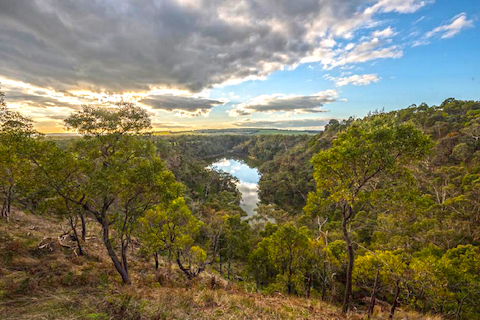
Credit: Cafuego (CC BY-SA 2.0)
You’re about to hear what may be the oldest story ever told.
In another EarthDate, we talked about how Australian Aboriginals remember star maps using songs. But their oral history has preserved much more in stories that corroborate ancient geological events.
For instance, they tell of a dramatic sea-level rise long ago that inundated areas of the coast. Many tribes, separated by great distance and different languages, tell the same story. And the details match the geological record of 7,000 years ago.
But there’s a far older tale.
A tribe in South Australia tells the creation myth of Budj Bim, a god who took the form of a volcano. His teeth became lava that spat from his mouth and flowed to the sea, creating the land that has sustained the tribe since the beginning of time.
The hill they call Budj Bim is in fact a long-extinct volcano. And its lava did flow to the sea, forming the coastal wetlands that the Aboriginals have used to practice aquaculture for thousands of years.
But the last time it erupted was 37,000 years ago. And no other volcanoes have erupted there since.
Archaeological and DNA testing have confirmed that this tribe has lived in the area for 40,000 years. It seems likely they witnessed the ancient eruption and preserved it in a legend that’s very much alive today.
So, the next time you’re asked for a good story, tell them the 37,000-year-old tale of Budj Bim, the volcano god.
Background
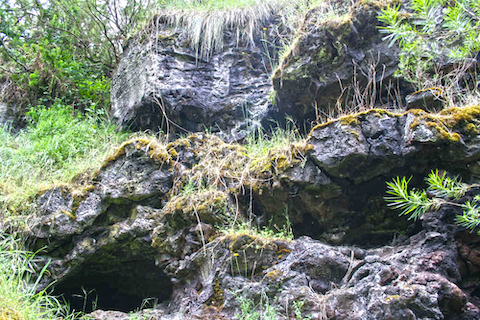
Credit: Robirensi
Synopsis: The southeastern Australian state of Victoria has been home to indigenous Australians for more than 40,000 years. Volcanic eruptions that occurred in the region about 37,000 years ago appear to have been incorporated into the local aboriginal creation story, or “Dreamtime,” which may be the longest surviving oral history still being passed on from generation to generation. This aboriginal civilization was remarkably resilient and sophisticated, having engineered a system of canals and weirs for aquaculture around 6,600 years ago—millennia before Stonehenge and the pyramids of Egypt were built.
- We previously talked about the population of the Australian continent by the First Nations people, who are also referred to as Aboriginal Australians, between 50–70,000 years ago.
- Most First Nations people live in northern and western Australia, but about 7% of Australia’s indigenous population lives in the southeastern state of Victoria (just north of Tasmania).
- Less than 1% of the population of Victoria (just 58,000 people) identifies as aboriginal.
- The southwestern region of Victoria is the ancestral home of the Gunditjmara people, who have lived there for at least 40,000 years.
- The Gunditjmara nation is one of several aboriginal nations in Victoria and is divided into 59 clans. Clan leadership is inherited through the matrilineal line.
- The Gunditjmara people speak a dialect known as Dhauwurd Wurrung.
- Gunditj- means “belonging,” and -mara is the word for “a local aboriginal person.”
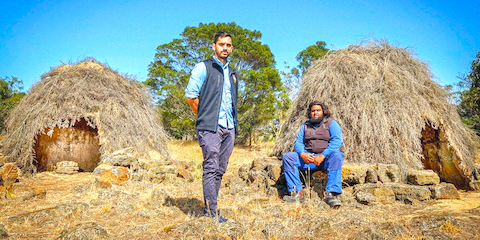
Credit: Shannon Morris
- Australia’s Budj Bim National Park is central to Gunditjmara culture.
- It is located near the southern coast of Australia in southwestern Victoria, midway between Adelaide (to its west) and Melbourne (to its east).
- The Budj Bim Cultural Landscape was designated a UNESCO World Heritage Site on July 6, 2019, for its cultural significance and for containing the remains of the world’s oldest aquaculture system.
- The park lies within an active volcanic system with more than 400 extinct volcanoes, but eruptions have occurred as recently as 5000 years ago.
- Budj Bim (which sounds like “Judge Jim”) means “high head” and is the name of the creator in the Gunditjmara “Dreamtime” creation story:
- In their Dreamtime legend, four creators were sent by the Great Creator to construct the Australian landscape. Three left and went to the north and east.
- But Budj Bim stayed, emerging as a violently erupting volcano, creating the mountain called Budj Bim (also called Mt. Eccles) and other nearby mountains.
- Budj Bim is a cone volcano that rises to 584 ft (178 m) at the intersection of three volcanic craters. Lava flows extend away from the craters toward the coast.
- The mountain is believed to be Budj Bim’s forehead, the scoria deposits (dark basalt containing vesicles made by air bubbles) produced by the volcano represent his teeth, and the lava flows are thought to be his blood that spilled over the plain, creating the wetlands that have supported the vitality of the Gunditjmara through millennia.
- The crater’s ridge is still known as the “High Head” and is a sacred place, visited only by Gunditjmara men in special emu-feather footwear.
- Budj Bim left guardians behind—weeping sheoak trees—to watch the people and ensure they are caring for the landscape. The trees whisper when the wind blows.
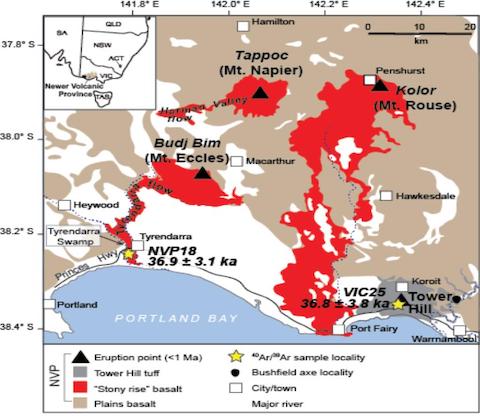
Credit: University of Melbourne
- Recent scientific studies have confirmed that volcanic activity at Budj Bim and 25 mi (40 km) southeast at Tower Hill occurred about 36,900 years ago.
- Human habitation in the area was established within a range of 30,000–57,000 years ago by carbon-14 dating of charcoal and optically stimulated luminescence dating of quartz grains in rock shelters, but datable evidence of habitation is difficult to find.
- A single stone artifact known as the “Bushfield Axe” was discovered in the 1940’s within finely layered volcanic ash east of Tower Hill, indicating eruptions occurred after aboriginal tribes had migrated to the area. But the Tower Hill complex had not been previously dated.
- In 2019, argon-40/argon-39 dating of volcanic rocks in the area provided ages of eruptions in the area: 36,900 ±3,100 years for the Budj Bim Volcanic Complex and 36,800 ±3,800 years for the nearby Tower Hill Volcanic Complex, where the Bushfield Axe was found.
- These findings corroborate that humans who used tools could have witnessed eruptions of volcanoes such as those represented in the creation story of the Gunditjmara nation.
- Aboriginal tales are some of the oldest on Earth and reflect a keen knowledge of nature.
- At 36,900 years, this story is the longest-surviving tale of a geological event—more than five times older than the 7000-year-old legends about sea level change that exist in several cultures.
- Research shows that aboriginal civilizations have tended to occupy the same location for up to 50,000 years, enabling their legends to survive.
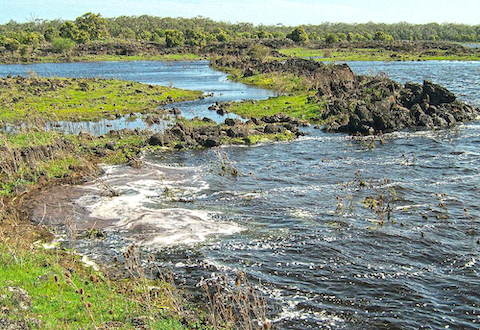
Credit: WEC2019
- But that is not the end of the story. The Gunditjmara were skilled engineers who built one of the earliest known aquaculture systems on Earth.
- The lava flows emanating from Budj Bim changed the drainage pattern of the region, creating extensive wetlands that provided rich hunting, gathering, and fishing to sustain the Gunditjmara people.
- Although many indigenous Australian tribes were nomadic, the Gunditjmara settled in the bountiful wetlands and moved from being foragers to farmers.
- By 6,600 years ago, the Gunditjmara had started eel farming, engineering a sophisticated system of stone eel runs and traps that are older than Stonehenge (built 5,000 years ago) or the Pyramids (built 4,500 years ago).
- They farmed short-finned eels and other fish, channeling young eels and creek water into low-lying areas and creating traps with basaltic lava rocks. The eels were available year-round to feed the people, who caught them by funneling them into long reed baskets.
- The Gunditjmara built more than 200 houses of basalt and wood with roofs of turf and branches around the shores of a lake in the wetlands, indicating they were living a settled agrarian lifestyle.
- In December 2019, an Australian fire caused by a lightning strike burned brush to reveal even more of the sophisticated system of canals and weirs that kept the people fed year-round. Australian fire crews employed low-impact firefighting techniques to preserve the site.

